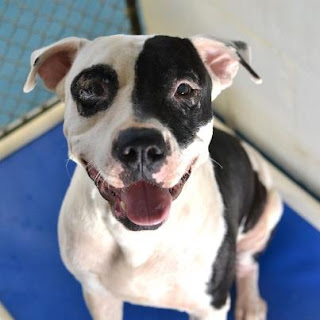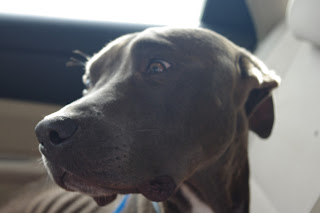Opie went from a cruelty case straight to the arms of his loving foster mom.
Noah was all smiles as he left the shelter.
We also helped dogs from Gilchrist and Levy counties, in collaboration with volunteers and veterinary professionals who have asked for our help. And in turn, we were able to send a heartworm positive dog from Gainesville to be treated at the Marion County Humane Society in Ocala. (That was Lilly, a perfect little dog who was adopted before she could come back to Gainesville!)
Lilly took to the creature comforts immediately.
Of the dozen dogs we took in directly as Plenty of Pit Bulls, eight were heartworm positive and most of the rest had other medical issues, ranging from Ella’s puncture wounds to Satchel’s eye condition. Several of these dogs have finished treatment and been adopted, while others will continue to need treatment in the new year.
Roxy came from the same cruelty case as Opie
Both were treated for heartworm at Shelter Medicine.
We ran up a huge debt to the amazing veterinary team at UF’s shelter medicine program. The debt is psychological, not financial – we paid all the bills, thanks to generous donations and pledges from people in Gainesville and beyond. Rescue groups put hundreds of dollars into every dog even without additional costs for conditions like heartworm or demodex. There are pull fees, monthly flea and heartworm treatments, food, microchipping, and supplies like crates, collars and leashes, and unexpected veterinary costs that often arise during the time a dog is in foster care. (Ella, for example, had a very expensive secondary bacterial infection after her original wounds were treated.)
Lucky Ella had a professional photographer for her foster mom.
Mr Big and Mr Little, later Champ and Chase, heading out.
We built relationships with several local dog trainers, who helped teach some of our volunteers and dogs. Training and behavior work is crucial to making dogs more adoptable and increasing retention in their adopted homes – and it also makes them easier to place and keep in foster homes. Training is also fun for dogs and handlers alike, adding to the bond and the enjoyment that make it all worthwhile.
Relationships -- between people and between people and dogs -- make everything we do possible. Building trust and communication helps a lot of dogs, including Bonnie, who was found by a Levy County volunteer and adopted to friends of a Gainesville volunteer, after being vetted thanks to Phoenix Animal Rescue.
Bonnie got a family of her own for Christmas!
Relationships of mutual trust also make it possible for us to help and be helped by groups out of town -- as in the case of Bandit, whom we pulled from ACAS and then transferred to an out-of-town rescue organization. In other cases, we have received similar favors from groups that pull from other shelters, such as Levy County. Working together and being flexible enables us to help more dogs.
A shelter volunteer fell in love with Bandit and made it possible
for him to be rescued out of town when local groups were full.
Harper sports his tutu with pride.
We have applied to pull dogs from Putnam County Animal Services, a neighboring shelter which, like other rural southern counties, has a high kill rate, low adoption rate, and few private or public resources. The dogs at Putnam are especially needy because the shelter refuses to let any dog labeled a pit bull or bulldog mix to be adopted out directly. They can leave the shelter alive only if they are pulled by a rescue organization. We look forward to being able to help a few of these dogs in the new year.
Like so many of the dogs we helped rescue,
Copper left his difficult past behind.
First, we would like to recruit more committed volunteers. We need people who can help train foster dogs and also take them on outings to socialize them and expose them to potential adopters. We also, of course, always need foster homes – both for the dogs we pull as POPB and must keep in foster homes during their treatment and for the dogs who are transferred to rescue partners for adoption.
Sadie was scared and depressed at the shelter.
A loving foster home put a smile on her face,
and Helping Hands Rescue found her a family of her own.
and Helping Hands Rescue found her a family of her own.
Second, we would like to have some successful fundraising projects, so we are not relying so heavily on individual donations.
Sterling (formerly Jesse) had nearly starved to death by the time he was rescued.
Today he is happy, healthy, and ready for adoption from Phoenix Animal Rescue.
Third, we would like to have some community events that are fun and educational for everyone involved. In addition to events like Pit Walks, picnics, and dog hikes we’d like to try something a bit more ambitious, like free or low-cost vaccinations in low-income areas.
To us, a "pit bull" is any dog who needs a little extra help,
including our gorgeous hound mix, gentle Jack.
One-eyed, heartworm positive Asha was dumped from a truck with her puppy.
The puppy was killed by a car, but Asha was rescued and is now safe, happy, and loved.


















































